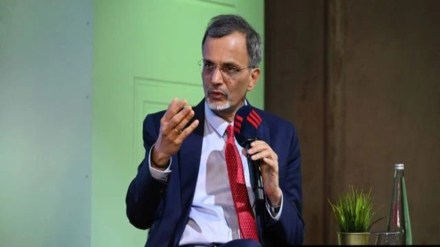In a lively, much-awaited and well attended Express Adda, organised by the Indian Express Group in Mumbai on Wednesday evening, Dr Anantha Nageswaran, chief economic advisor, government of India, spoke of the impact of the high tariff imposed by the US on exports from India. But then, reminded that despite the challenges it was still not all gloom and doom as some of the compensating factors would also start taking effect next year.
On the numbers and time period of the impact, he felt that considering that there was a front loading of exports till August this year, the effects would start playing out in the second and third quarters. The order of magnitude could be 0.3 per cent to 0.5 per cent this year in terms of real GDP impact, he said. However, a full impact will be felt next year assuming the current situation continues, which to him was unlikely to persist.
Elaborating on the point that it was unwise to view it as all gloom and doom, he referred to the compensating factors that could be expected by next year. For instance, we would have also had a full year of lower direct and indirect taxes, the efforts of discovering newer markets would have started bearing fruit, also the free trade agreement with the European Union would have come into place.
Navigating global export challenges
Conscious of the fact that in general export growth was in any case likely to be a challenge in the coming years not on account of trade restrictions alone but because growth in the developed world was going to be difficult. If there is no underlying demand, the export opportunities will be limited, he said.
Also in sync with the fact that finding alternate markets could not happen overnight, he opined, “finding other markets will be possible but not easy because China is also having its own challenges with respect to exports to the US and will be competing for a share in other markets.” Also, not missing the fact of their higher ability to finance buyers and extending long lead time for payments apart from offering product and price discounts.
The chief economic advisor saw lessons for other sectors of the economy in the story of the Indian pharma industry’s response in 1995 following the TRIPS agreement. The Indian pharma took to upping their investments into research and development taking these up to between 4 and 7 per cent of their turnover.
Ease of being honest
The CEA also pointed to efforts within the government to move on the path to deregulation with a sense of heightened urgency. He described it as the one secret sauce that we have to juice up growth. And it was “not so much about ease of doing business but about ease of being honest.”
In a fun-filled and insightful rapid fire round with Anant Goenka, executive director, The Indian Express Group, the CEA chose land reforms over labour reforms for a higher multiplier effect, albeit he did find both important. To the CEA, the land reform was more about fixed cost of doing business. From a foreign investors’ perspective it was more about tax certainty and tax processes – advance pricing agreements and safe harbour limits coupled with day-to-day interactions and processes. It was more about time taken to resolve issues and about setting time limits and sticking to those.
